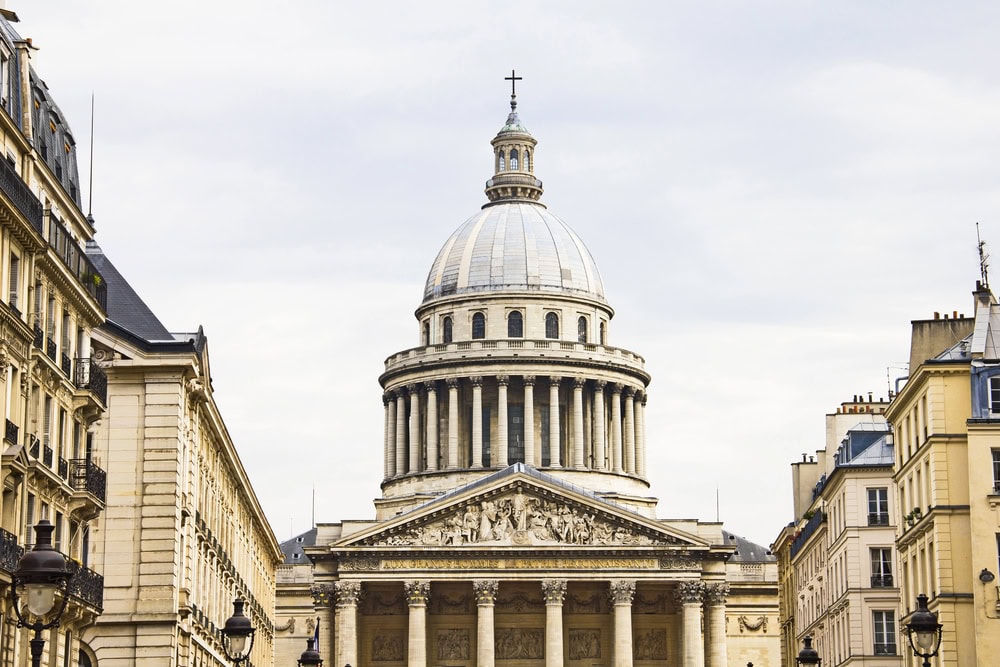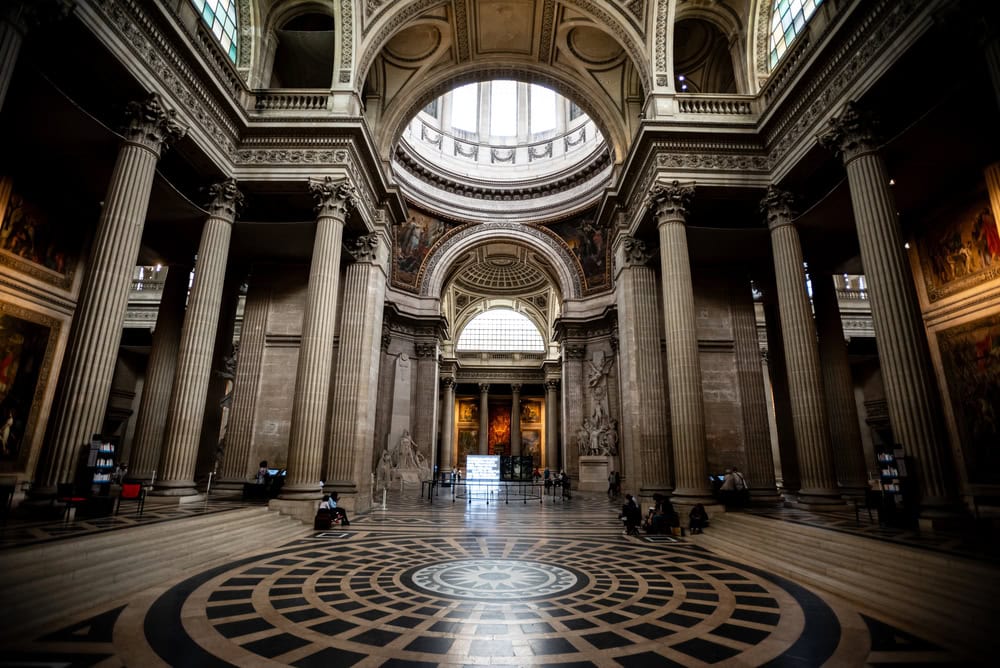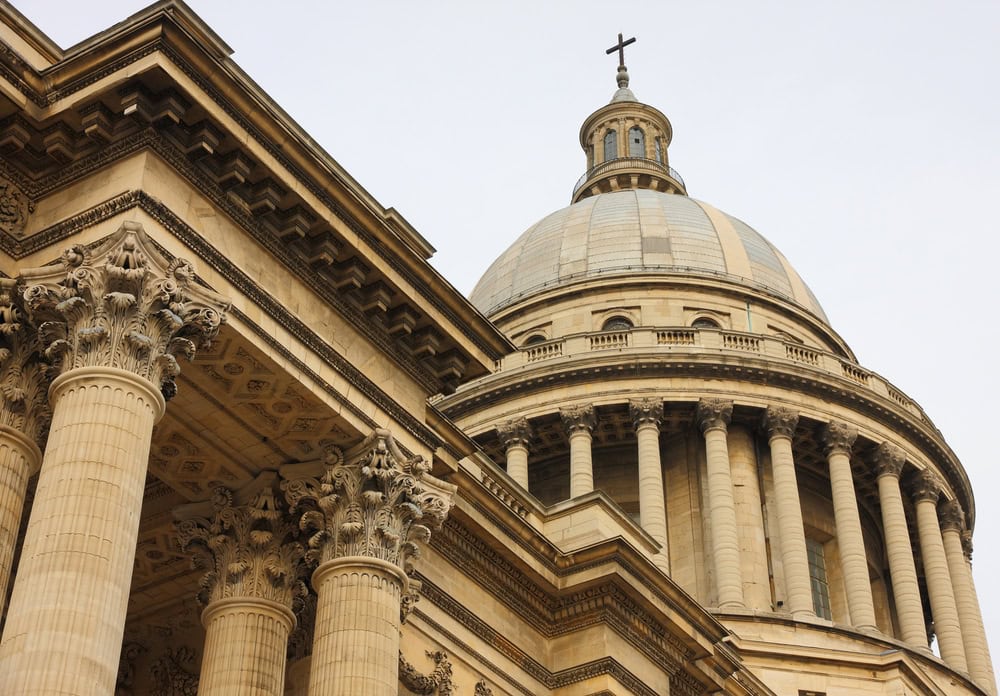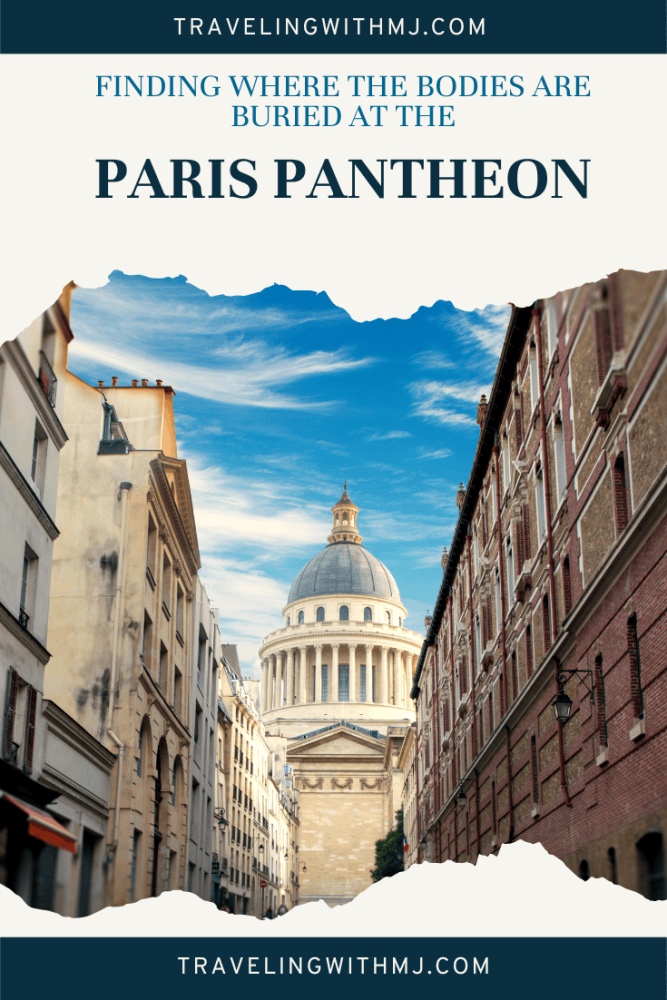Paris is known for its charming architectural attractions, rich history, bold romantic overtones, exquisite food, and more. On my first visit to France, I visited the Paris Pantheon, a neoclassical church in the Latin Quarter of Paris, and it quickly became one of my favorite places in the city.

A Royal Promise and Turbulent History
The Pantheon’s story begins with a royal vow. In 1744, King Louis XV fell seriously ill during the War of Austrian Succession (it was later to be gout). He promised to build a grand church dedicated to Saint Genevieve, the patron saint of Paris, if he recovered. He recovered, and true to his word, he commissioned the construction of what would become the Pantheon.
However, all did not go smoothly and the project faced numerous challenges right from the start. The King spent wildly on his many other pursuits, and his overspending led to a lack of funds for the Pantheon project. The site, formerly the location of church of Sainte-Genevieve, had unstable soil conditions and required additional funds to stabilize.
Not one to be deterred, the King came up with an unusal. for the time, fundraising method – a royal lottery. Construction of the Paris Pantheon finally began in 1758 under the supervision of architect Jacques-Germain Soufflot. The project progressed slowly, taking 34 years to complete. Sadly, neither Louis XV nor Soufflot lived to see its completion in 1790.
The French Revolution brought significant changes to the building’s purpose. In 1791, the newly-completed structure was transformed from a church into the “Temple of the Nation,” a shrine to honor the heroes of France. This marked the beginning of the Pantheon’s role as a civic monument and mausoleum for distinguished French citizens.
Throughout the 19th century, the Pantheon’s function moved back and forth between a church and a secular monument, changing no fewer than six times as each political shift brought about different priorities. It wasn’t until the funeral of Victor Hugo in 1885 that the Pantheon definitively retained its role as a civic building and final resting place for France’s most illustrious figures.
Architectural Marvel: Blending Styles and Innovation
The Pantheon stands as a testament to Soufflot’s visionary design, blending elements of Neoclassical and Gothic styles. His goal was to combine the lightness and brightness of Gothic cathedrals with classical principles, creating a truly structure worthy of France and its citizens.
Exterior – The building’s dimensions are impressive: 260 feet long by 278 feet wide, standing at a height of 272 feet. At is completion in 1790 it was the tallest building in Paris, and remained so until the construction of the Eiffel Tower in 1889, the Panthéon was the tallest building in Paris. The imposing facade features 22 Corinthian columns supporting a triangular pediment, and is reminiscent of the Pantheon in Rome. Above the entrance, you’ll spot the inscription “AUX GRANDS HOMMES LA PATRIE RECONNAISSANTE” (To great men, the grateful homeland).
Interior – Stepping inside, you’re immediately struck by the airy, church-like interior. Soufflot’s innovative design features slender columns supporting a massive vault, creating a sense of lightness and space. To achieve this design, he strengthened the stone structure with a system of iron bars – a bold innovation for its time. The Greek cross layout and soaring dome create an awe-inspiring atmosphere. The dome, when viewed from inside and bathed in sunlight, is particularly impressive.

Artistic Treasures
The Pantheon houses an impressive collection of art that reflects its dual history as both a church and a secular monument.
Frescoes and Paintings – The interior is adorned with lavish frescoes and paintings. The dome features “The Apotheosis of Saint Genevieve,” a nod to the building’s original purpose, and the wall murals depict scenes from Saint Genevieve’s life and key moments in French history. Interestingly, many of these “frescoes” are actually oil paintings created using the marouflage technique. Artists in the 19th century painted scenes on canvas and then affixed them to the walls, resulting in vibrant, long-lasting artworks.
Sculptures and Bas-Reliefs – Throughout the Pantheon are marble sculptures and bas-reliefs that blend secular and religious themes. One of the most impressive is “La Convention Nationale,” a major sculptural composition that captures the spirit of the French Revolution.
The Crypt: A Who’s Who of French History
The Pantheon’s crypt is a veritable hall of fame for French luminaries. It may sound morbid, but the necropolis is also a work of art. More than 70 famous men, and five notable women, are buried in the subterranean chamber. There’s a permanent exhibition that provides information on the lives and achievements of those interred here.
Over the years, there has been heated debate over who deserves and doesn’t deserve to be buried in this civic building, and today it takes an act of Parliament to be buried there. The notable figures interred here include:
- Writers: Victor Hugo, Emile Zola, Alexandre Dumas
- Scientists: Marie and Pierre Curie, Louis Braille
- Philosophers: Voltaire, Jean-Jacques Rousseau
- Politicians: Jean Jaures, Leon Gambetta
In recent years, efforts have been made to honor more women and diverse individuals. Marie Curie became the first woman interred based on her own merits in 1995. More recently, Simone Veil, a Holocaust survivor and women’s rights advocate, was interred here in 2018. Men still outnumber the women buried here.
Scientific Legacy: Foucault’s Pendulum
The Pantheon isn’t just a monument to history and art; it’s also played a role in scientific discovery. In 1851, physicist Leon Foucault used the building to demonstrate the Earth’s rotation with his famous pendulum experiment. He built the pendulum to conduct experiments demonstrating the earth’s rotation on its axis – against the then-conventional belief that the earth stayed still. The pendulum was installed in 1851 but was later moved to the Musée des Arts et Métiers, before returning to the Pantheon.
Today, a replica of Foucault’s pendulum hangs beneath the central dome of the Pantheon. It swings in a mesmerizing arc and continuing to captivate visitors with this elegant proof of the rotation of the earth.
Climbing Up to the Panorama
There are 206 steps up the colonnade beneath the dome, and it gives way to one of the most impressive viewing spots in Paris.
There are three distinct flights of stairs going up. The first flight elevates you to appreciate the amazing interior of the Pantheon. Next, you’ll head to a mezzanine with great views of city landmarks such as the Rue Scufllot and the Eiffel Tower. If you go up the final flight of stairs, you’ll get an all-around view of Paris. That view from the top is spectacular – a 360-degree view of all that Paris has to offer from a colonnaded balcony. Walk around the top, take it all in, and see which Paris landmarks you can spot.
The way is narrow and steep and sometimes can be a little disorienting. Don’t worry about making the climb at record speed — go slow and rest along the way if you need to. You won’t be the only one

Visiting the Pantheon: Personal Recommendations
As someone who’s visited the Pantheon multiple times, I always discover something new. Here are my top recommendations:
- Climb the dome: The 206 steps are worth it for the panoramic views of Paris. (Available April to October)
- Take your time in the crypt: Read the plaques and reflect on the contributions of those interred here.
- Admire the art: Pay special attention to the marouflaged canvases and the blend of religious and secular themes.
- Watch Foucault’s pendulum: Take a moment to appreciate this elegant demonstration of physics.
- Visit during off-peak hours: Early morning or late afternoon for a more serene experience.
- Check for special exhibitions: The Pantheon often hosts temporary exhibits that provide new perspectives on French history and culture.
- Combine your visit with other nearby attractions. We usually follow up with spending time in Luxembourg Gardens. Saint-Etienne-du-Mont church is also nearby.
Need to Know
- Address: Place du Pantheon, 75005, Paris, in the 5th arrondissement (known as the Latin Quarter of Paris).
- Nearest Metro: The nearest metro is Cardinal Lemoine, and the nearest RER is Luxembourg, both stations about a seven minute walk to the Pantheon.
- Hours: Generally 10 am to 6 pm, with extended hours during peak season.
- Admission: €13 for adults, with various concessions available for those under 16, disabled patrons and their accompanying guest, students, and teachers. It is also an included attraction on the Paris Museum Pass.
- Guided tours: Available and highly recommended for in-depth insights.
- Accessibility: The main floor is wheelchair accessible, but the dome and crypt have stairs.
- Official website here.
The Pantheon’s Enduring Legacy
The Pantheon stands as a testament to France’s rich history, cultural heritage, and ongoing evolution. It embodies the nation’s journey from monarchy to republic, from religious devotion to secular humanism. Yet, it also continues to adapt and remain relevant, hosting contemporary art and addressing modern issues.
As you walk through its grand halls, climb to its dome, or descend into its crypt, you’re not just visiting a monument – you’re experiencing the heart of French identity and achievement. Whether you’re a history buff, architecture enthusiast, art lover, or simply looking for a unique Parisian experience, the Pantheon offers a special look at it all.
Stand where great men and women have stood, ponder the sweep of history, and let yourself be inspired by the enduring spirit of France at the Paris Pantheon.
Save this to your favorite travel and Paris Pinterest boards and plan your visit to the Paris Pantheon.


